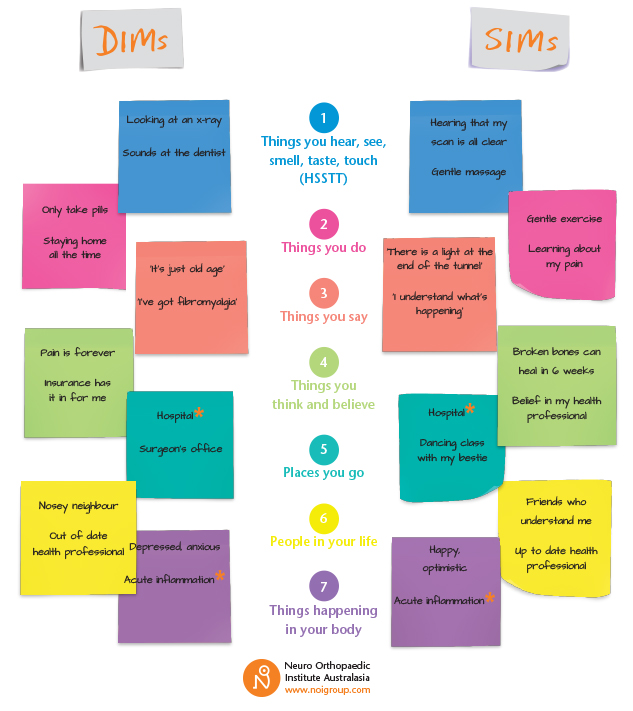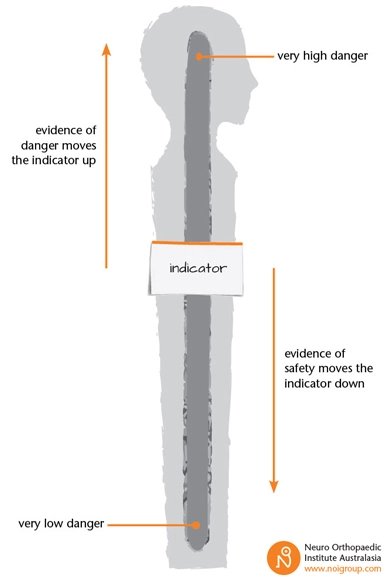The Balancing Act of Pain

Think about your grandmother. What are some of your favorite memories with her? Can you smell her perfume? Can you see her in her favorite blouse? Can you taste her famous cookies? How did she make you feel?
While taking this trip down memory lane, there are several parts of your brain active, not simply one “Nana Lobe.” This is how pain works in our brains as well. Because it involves so many different aspects (think back to that complex Biopsychosocial Model), pain can be changed for better or worse by many different things (Moseley & Butler, 2017).
It can be helpful to identify some of these things and know whether to categorize them as helpful or hurtful. According to Moseley and Butler, things that could change pain for the worse are called DIM’s (Danger-In-Me). These are things that are perceived as dangerous to our “body tissues, day-to-day function, and happiness.” Things that could change pain for the better are called SIM’s (Safety-In-Me). These are things that are perceived to make you “stronger, healthier, and more confident.” DIMs and SIMs can come from countless areas, for instance, the things you think, say or do, places and people you encounter, even things happening inside of your body. See below for examples of each:

- (Butler and Cocks, 2015)
Notice how one object could go in either category, a danger or a safety message. Let’s take inflammation as an example. We need inflammation to heal. Inflammation is also a protector, making danger detectors more sensitive (this is why a sprained ankle hurts early on while healing). The extra sensitivity is similar to giving a security guard (a danger detector) a strong cup of coffee (inflammation), making him way overprotective of his territory while it is trying to heal. Therefore, inflammation can be a protector (a SIM) when healing but can also become a DIM when we have too much inflammation for too long.
To help control these overprotective situations, our bodies produce cortisol. Cortisol is an anti-inflammatory hormone that rushes through the body during stressful situations (think DIMs), such as trauma, work deadlines, a haunted house, even exercise. However, about 50% of people with persistent pain do not produce enough cortisol to control inflammation. These 50% do not respond well to stressful situations, leading to overprotective inflammation and flare ups. In these cases, it is important to increase SIMs and have stress management techniques, including meditation, to lower inflammation (Pain in Motion, 2019).
Let’s think about another pain management technique: cracking your back. The pain relief from that crack is not really from physical change in your joints and tissues. The more likely explanation for pain relief is due to a change in your DIMs and SIMs, and due to accessing your natural pain relievers (serotonin, enkephalin, opioids, dopamine, and morphine-like substances, but more on this later). Pain relief comes from increasing the safety messages around you:
- Being in the safe hands of your practitioner
- Expecting the technique to work
- The “crack” sound and feeling
- Your practitioner believing the technique has worked
All of these messages go to the spinal cord and reduce the danger messages, creating a situation where SIMs outweigh DIMs (Moseley and Butler, 2017).

Now let’s flip this example the other way. Picture someone who is deathly afraid of having their neck cracked, they do not trust their practitioner, and they believe that a crack means damage. Now DIMs outweigh SIMs and that “crack” has produced high levels of pain because the body believes it needs protecting.

The pain you do or do not feel is based on a very fine balance between DIMs and SIMs in your system. If you perceive your danger messages to outweigh safety messages, your brain will produce pain to protect the area in question. However, once safety messages start to outweigh danger messages, pain will reduce. Check out this Protectometer from Moseley and Butler to help visually gauge danger and safety messages.

(Butler and Cocks, 2015)
For more information on this, I can direct you towards “The Explain Pain Handbook: Protectometer” by Moseley and Butler.
[I do not have a relationship with this group and do not receive an income from them]
Stay tuned for more posts about how to adjust your danger and safety messages, and about what language and memory have to do with pain.
- Moseley, G. L. & Butler, D. S. (2017) Explain Pain Supercharged. Noigroup Publications.
- Butler, D. and Cocks, T. (2015, March). DIM SIMs. NOI jam. https://noijam.com/2015/03/12/dim-sims/
- Pain in Motion (2019) Moving Despite Pain [Powerpoint Slides]. Retrieved from Align Conference.
Post Written by PRO’s Own Sarah Geraghty

